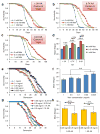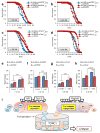Methionine restriction extends lifespan of Drosophila melanogaster under conditions of low amino-acid status
- PMID: 24710037
- PMCID: PMC4350766
- DOI: 10.1038/ncomms4592
Methionine restriction extends lifespan of Drosophila melanogaster under conditions of low amino-acid status
Abstract
Reduced methionine (Met) intake can extend lifespan of rodents; however, whether this regimen represents a general strategy for regulating aging has been controversial. Here we report that Met restriction extends lifespan in both fruit flies and yeast, and that this effect requires low amino-acid status. Met restriction in Drosophila mimicks the effect of dietary restriction and is associated with decreased reproduction. However, under conditions of high amino-acid status, Met restriction is ineffective and the trade-off between longevity and reproduction is not observed. Overexpression of InRDN or Tsc2 inhibits lifespan extension by Met restriction, suggesting the role of TOR signalling in the Met control of longevity. Overall, this study defines the specific roles of Met and amino-acid imbalance in aging and suggests that Met restiction is a general strategy for lifespan extension.
Conflict of interest statement
The authors declare that no competing financial interests exist.
Figures








References
-
- Bosshardt DK, Paul WJ. Caloric restriction and protein metabolism in the growing mouse. J Nutr. 1948;36:773–783. - PubMed
-
- Koubova J, Guarente L. How does calorie restriction work? Genes Dev. 2003;17:313–321. - PubMed
-
- Lin SJ, et al. Calorie restriction extends Saccharomyces cerevisiae lifespan by increasing respiration. Nature. 2002;418:344–348. - PubMed
Publication types
MeSH terms
Substances
Grants and funding
LinkOut - more resources
Full Text Sources
Other Literature Sources
Medical
Molecular Biology Databases
Miscellaneous

